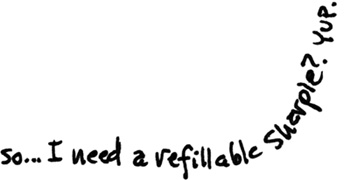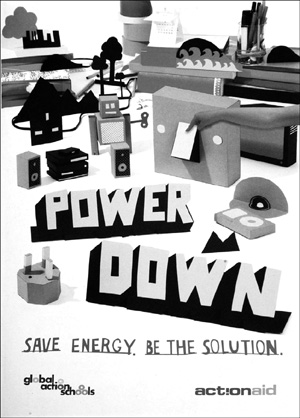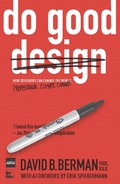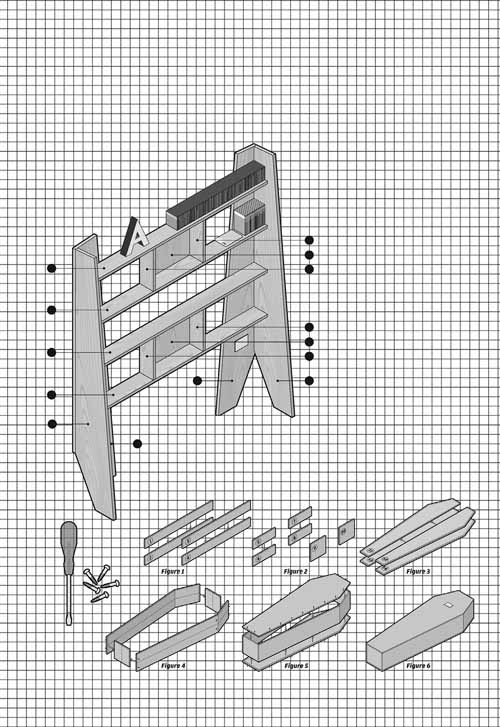I’VE ARGUED STRONGLY that sustaining our environment, so that future generations can meet their needs as easily as we can, is the largest challenge in designing a better civilization. Up to this point, we’ve focused on how our end products can affect global sustainability. However, our process has as much impact as our products. Particularly in a creative industry, the process influences what gets produced, because how we work affects our creative process.
Put more personally: if a designer is who you are, then what you create reflects how you think.
Our creativity makes us innovators in the eyes of our clients: we are opinion leaders when it comes to process. So the next time you pull out a disposable pen at a client briefing, think about this: when ballpoint pens came onto the market right after the Second World War, one cost a very non-disposable $120 (in today’s dollars). Before today is done, across five continents, BIC will sell over 14 million ballpoint pens.[120] That’s approximately one pen a year for each person on Earth. And that’s just BIC. China exports over $1 billion of disposable pens yearly (and in 2008, China also became their largest consumer).[121] Where do all those used pens go? Landfill. And that is where they decompose for 200 to 400 years, after their 6- to 12-month useful life.

Landfill waiting to happen
It gets worse: BIC states that 13 percent of its hazardous production waste and 29 percent of nonhazardous production waste also ends up in landfill.[122] The products you consume are only the tip of the consumption iceberg: what you hold in your hand is typically only 10 percent of the materials consumed in creating them.[123]
So although recycling helps, you are not avoiding landfill, just delaying it. Meanwhile, if we embrace only recycling as the answer, it becomes the consumer equivalent of tossing back too many low-fat potato chips or sugar-free sodas and thinking that alone will make you healthier.
So jot this down: make a better impression at your next meeting with a classy, nondisposable pen. A refillable Parker that reflects your personality and wardrobe carries a 50-year guarantee. (But my favorite is the Fisher Space Pen: tiny, elegant, and writes underwater!)
That’s a complex load of baggage for one little pen, and that’s the point: as a profession, we should pick up each object and reflect on the choices it represents.

We must embrace sustainable practices specific to design work (think paperless proofing) as well as green procedures that would apply to any office (think paperless invoicing).
The printing industry is the third largest waste producer on Earth. And almost half of mailed material is trashed without being opened.
The specifics of sustainable design practice are shifting very quickly (and positively). It is unwise to try to describe this moving target of paper composition, vegetable inks, and “waste miles” in print (instead see the online link later in this chapter to take you to some specifics).
“The frog does not drink up the pond in which she lives.” | ||
| --BUDDHIST PROVERB | ||
What is not in flux are these three points of good news:
Sustainable design practices won’t take any more time than what you do now, once you are familiar with them.
Sustainable design practices will, on balance, save money for both you and your clients.
You don’t have to do it all at once. Try one thing on your next project. Then once you’ve mastered that, try another, and so on... (If you must be intimidated, I’d rather it be by this fourth truth: sustainable design practice will rapidly become the standard. If you don’t learn this stuff, you are going be left behind.)

Your Ocean is a permanent maritime gallery constructed entirely from reclaimed, recycled, and sustainable materials

Climate change campaign for schools in the UK
For instance, here’s something to try in your next proposal: include an optional line item to cover the cost of making the entire project carbon-neutral (or even better, carbon-positive). We have yet to encounter a client who found this choice distasteful.
If you’re not already aware of the details of sustainable design practice, get educated.
Most importantly, designers, like all in business, need to learn about the triple bottom line: people, planet, profit. This has become the dominant approach to full-cost accounting: it expands traditional accounting reporting to include social and environmental corporate performance alongside financial performance. Sustainable design is good economics. We need to apply the triple bottom line to our own business plans, as well as the success measures for every project.
Once you’ve educate yourself about sustainable practices, practice injecting such ideas into every project and procedure until it becomes second nature.
Strive to surround yourself only with well-designed reusable, sustainable products and processes.
If you are already up to speed on how, then help spread that know-how and habit by example, and perhaps even push the envelope (a reused envelope of course!) of what is acceptable in your community.
Visit www.davidberman.com/dogood for an evergreened list of resources and groups in the design community that are developing sustainable practices you can start to implement right away.

